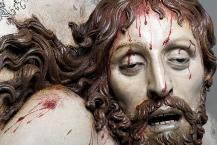Period Band B
Curatorial Rating: unrated
The Power of the Real in Seventeenth-Century Spanish Painting and Sculpture
Tutor: Cordula Van Wyhe
Description
The semblance of art and reality was a recurring concern for seventeenth-century artists and theorists. Consequently, art historians have long tried to grapple with, what has been variously termed, the “life-like effect”, “photographic quality”, “verisimilitude”, “illusionism” and “optical trickery” of seventeenth-century painting and sculpture.
This module will take Spanish sculpture and painting as a case study to explore the wider conceptual and methodological challenges of the power of the real. Seventeenth-century Spain is often referred to as “Golden Age Spain”. Despite grave challenges to Spain’s power in the international arena of politics and commerce, the literary and visual arts and architecture flourished to an unprecedented degree. The artistic trends which dominated image-making in Seville at the turn of the seventeenth century are generally considered the bedrock of what scholars have termed, “the art of immediacy”, or “naturalism” in Spain. For example, Spanish sculptors such as Pedro de Mena, Juan de Mesa and Juan Martínez Montañés achieved new life-like effects in their polychrome sculptures, while painters such as Francisco Zurbarán and Diego Velázquez, who both had strong links to Seville, produced several canonical pieces whose hallmark is their power of illusion.
“Realism” is always a relative term, because its meaning is informed by the practices of a specific culture. This module will engage with the important methodological problems that surround the privileged explanatory category of “realism” for seventeenth-century painting and sculpture in Spain. We will investigate the wide variety of pictorial, thematic and conceptual strategies in close relation to contemporary texts and modern, scholarly theoretical writings.

Module code: HOA00053I
